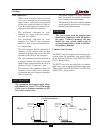
30
Fuel Piping
General Oil Piping Guidelines
Location and installation of oil tanks, oil piping
and burners must comply with:
- NFPA 31, Standard for the Installation
of Oil-Burning Equipment
- Local codes and regulations
- Manufacturer’s information provided
with the burner and oil pump.
For installations in Canada, CSA B139,
Installation of Oil-Burning Equipment
If the fuel tank is installed or any part of the
fuel tank is above the level of the burner, an
anti-siphon device must be installed to prevent
the spillage of oil in the event of an oil line
break.
Support oil line as required by local codes.
All tank connections should be made using
swing joints or copper tubing to prevent possi-
ble line breakage in the event of tank settle-
ment. When using swing joints ensure they are
made to tighten as the tank settles. All thread
connections should be made with a non-hard-
ening pipe joint compound.
Do not use Teflon tape to seal any oil con-
nections. Teflon tape can cause oil valves
to fail, creating potential hazards. Do
not use compression type fittings at the
burner all fittings should be flare type.
WARNING


















